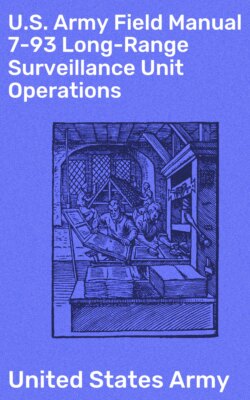Читать книгу U.S. Army Field Manual 7-93 Long-Range Surveillance Unit Operations - United States Army - Страница 8
1–3. ARMY OPERATIONS DOCTRINE
ОглавлениеThe most pressing concern of a corps or division commander engaged in combat is knowledge of the enemy to his front or to his flanks, and how that enemy may affect his mission. The commander must surprise the enemy and catch him at a disadvantage as often as possible. To do so, the commander must see well forward and know the areas of operation and interest. He must also know the enemy's capabilities, strengths, location of reinforcements, density of air defense, and activities. This information is obtained through intelligence activities that provide the basis for tactical and operational decisions. Conduct of Army operations is based on timely intelligence from organic and higher sources at corps. Real-time human intelligence information is needed to complement electronic and imagery intelligence systems. The LRSUs at corps and division play an active part in the Army operations by providing that information. FM 100–5 states that success on the battlefield depends on all commanders knowing and implementing the five basic tenets of Army operations doctrine: initiative, agility, depth, synchronization, and versatility.
a. Initiative. Initiative sets or changes the terms of battle by action. It implies an offensive spirit in all actions. It means departing from planned actions when an opportunity presents itself to hasten mission accomplishment. The LRSUs provide the corps and division commanders near real-time information on the enemy. This information does not need lengthy processing and analysis, thus enabling commanders to take the initiative when the opportunity presents itself.
b. Agility. Agility involves thinking and acting faster than the enemy. It involves the mental, command and control, and organizational ability to evaluate METT-T factors and then shift rapidly to destroy the enemy. The LRSUs provide commanders timely information that enables them to act swiftly and take advantage of the enemy situation. Because of the communication systems that LRSUs use, and mobility restrictions, LRS teams are not responsive to changes in the mission once deployed.
c. Depth. Depth is measured in time, distance, and resources. The commander uses available time and the depth of the battlefield to employ his forces to defeat the enemy. Depth is the greatest contribution of the LRSUs in Army operations. The units give corps and division commanders the ability to see deep into the enemy's rear.
d. Synchronization. Synchronization is teamwork and coordination of effort. The commander must know how the combined-arms team is used to defeat the enemy. Synchronization is a unity of effort following the commander's intent. This unity extends from the maneuver plan to the integration of CS and CSS assets to ensure mission accomplishment. Information provided by the LRSUs and integrated with other forms of information-gathering assets give the commander a coordinated effort and better understanding of the battlefield.
e. Versatility. Versatility is the ability of units to meet diverse mission requirements. Commanders must shift focus, tailor forces, and move from one role or mission to another rapidly and efficiently.
